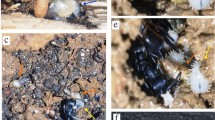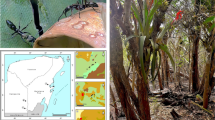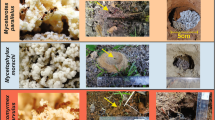Summary
The distributions of three “forms”, actually sibling species, of meat ant were studied near Morgan, South Australia, an area with mean annual rainfall of 230 mm. Colony dispersion is described for a “blue form” and for formpurpureus sens. strict. which occurs in this locality far beyond its normal low rainfall limit. An unusually large colony ofpurpureus had a territory covering 10 ha with more than 85 nests and over 1,500 individual nest entrances. Worker interactions between forms, and within and between colonies within forms are described.
The ant fauna of the locality as a whole and the faunas accompanying differentIridomyrmex species were investigated by means of hand collections and pitfall trapping. Diversity (species — richness) and the occurrence of widely adapted ant species are related to vegetation type and associatedIridomymex. Catches of pitfall traps suggested that the numbers of individuals and species of other taxa active on the soil surface, predominantly Collembola, were affected by numbers of ants, particularlyIridomyrmex species and other, widely adapted ants.Iridomyrmex also influence associated fauna at an evolutionary level. The presence of zodariid spiders which are sibling species-specific colour mimics and predators of meat ants is noted. Possible cases of mimicry of meat ants by ants of the genusCamponotus are recorded and discussed.
Resume
Les distributions de trois «formes», en réalité des espèces jumelles d'Iridomyrmex purpureus furent étudiées près de Morgan en Australie du Sud, où la précipitation annuelle est de 230 mm. La dispersion des colonies a été décrite en détail pour une «forme bleue» et pour la formepurpureus sens. strict. qui existait dans cette région bien au-delà de ses limites pour les basses précipitations. Une colonie exceptionnellement grande d'I. purpureus couvrait un territoire de 10 ha: comprenant plus de 85 nids, elle avait plus de 1 500 entrées individuelles. Nous avons décrit les interactions entre les ouvrières des différentes formes, et leurs interactions au sein et entre les colonies de la même forme.
La totalité de la faune de fourmis de la région et les faunes qui accompagnaient les différentes espèces d'Iridomyrmex furent étudiées au moyen de récoltes faites à la main et de piègeages dans des fosses. La diversité (abondance d'espèces) et la présence d'espèces de fourmis sans adaptations particulières sont liées au type de végétation et auxIridomyrmex associées. Les prises dans les pièges suggérant que le nombre d'individus et le nombre d'espèces d'autres taxons actifs à la surface du sol, en particulier les collemboles, sont affectés par le nombre de fourmis, en particulier les espèces d'Iridomyrmex et d'autres fourmis sans adaptations particulières. Au niveau évolutif, lesIridomyrmex influencent aussi la faune associé. On a noté la présence d'araignées zodariides présentant un mimétisme de couleur par rapport aux espèces presque identiques d'I. purpureus, dont ils sont des prédateurs. Nous avons noté et discuté des cas possibles de mimétisme d'I. purpureus par des fourmis du genreCamponotus.
Similar content being viewed by others
References
Craig R., Crozier R.H., 1979. — Relatedness in the polygynous antMyrmecia pilosula.Evolution, 33, 335–341.
Ettershank G., 1978. — Aquisition of water from soil by the meat-ant,Iridomyrmex purpureus (Smith) (Hymenoptera: Formicidæ).Insectes Sociaux, 25, 31–38.
Ettershank G., Ettershank J.A. (in press). — Ritual fighting in the meat ant,Iridomyrmex purpureus (Hymenoptera: Formicidæ).J. Aust. Ent. Soc.
Greaves T., Hughes R.D., 1974. — The population biology of the meat ant.J. Aust. Ent. Soc., 13, 329–351.
Greenslade P.J.M., 1970. — Observations on the inland variety (v.viridiœneus Viehmeyer) of the meat antIridomyrmex purpureus (Frederick Smith) (Hymeonoptera: Formicidæ).J. Aust. Ent. Soc., 9, 227–231.
Greenslade P.J.M., 1973. — Sampling ants with pitfall traps: digging-in effects.Insectes Sociaux, 20, 343–353.
Greenslade P.J.M., 1974. — Distribution of two forms of the meat ant,Iridomyrmex purpureus (Hymenoptera: Formicidæ), in parts of South Australia.Aust. J. Zool., 22, 489–504.
Greenslade P.J.M., 1975a. — Dispersion and history of a population of the meat antIridomyrmex purpureus (Hymenoptera: Formicidæ).Aust. J. Zool., 23, 495–510.
Greenslade P.J.M. 1975b. — Short-term change in a population of the meat antIridomyrmex purpureus (Hymenoptera: Formicidæ).Aust. J. Zool., 23, 511–522.
Greenslade P.J.M., 1976a. — The meat antIridomyrmex purpureus (Hymenoptera: Formicidæ) as a dominant member of ant communities.J. Aust. Ent. Soc., 15, 237–240.
Greenslade P.J.M., 1976b. — Distribution of two forms of the meat antIridomyrmex purpureus (Hymenoptera: Formicidæ) on Kangaroo Island and in the Yorke Peninsula.Aust. J. Zool., 24, 557–564.
Greenslade P.J.M., 1979. —A Guide to Ants of south Australia. South Australian Museum, Adelaide.
Greenslade P.J.M., Greenslade P., 1977. — Some effects of vegetation cover and disturbance on a tropical ant fauna.Insectes Sociaux, 24, 165–182.
Greenslade P.J.M., Greenslade P. (in press). — Some soil surface insects of the Australian arid zone. Australian Museum, Sydney.
Halliday R.B., 1975. — Electrophoretic variation of amylase in meat ants,Iridomyrmex purpureus, and its taxonomic significance.Aust. J. Zool., 23, 271–276.
Halliday R.B., 1978. — Genetic Studies of Meat Ants (Iridomyrmex purpureus).Unpublished Ph.D. thesis, University of Adelaide.
Halliday R.B., 1979. — Esterase variation at three loci in meat ants.J. Hered., 70, 57–61.
Halliday R.B., 1983. — Social organisation of meat ants,Iridomyrmex purpureus, analysed by gel electrophoresis of enzymes.Insectes Sociaux, 430, 45–56.
Hölldobler B., 1976. — Tournaments and slavery in a desert ant.Science, 192, 912–914.
Hölldobler B., Wilson E.O., 1977. — The number of queens: an important trait in ant evolution.Naturwissenschaften, 64, 8–15.
Jessup R.W., 1948. — A vegetation and pasture survey of Counties Eyre, Burra and Kimberley, South Australia.Trans. R. Soc. S. Aust., 72, 33–68.
Mobbs C.J., Tedder G., Wade A.M., William R., 1978. — Foraging activity of the meat ant.J. Aust. Ent. Soc., 17, 193–197.
Potter J.S., Wetherby K.G., Chittleborough D.J., 1973. —A Description of the land in County Albert, County Alfred and Part of County, Eyre, South Australia. Dept. of Agriculture, South Australia.
Reiskind J., 1977. — Ant mimicry in Panamanian clubionid and salticid spiders (Araneæ: Clubionidæ, Salticidæ).Biotropica, 9, 1–8.
Reznikova J.I., 1975. — Non-antagonistic relationships of ants occupying similar ecological niches.Zoologischesekii Zhurnal, 54, 1019–1030 (In Russian with English Summary).
Wells R.T., 1978. — Thermoregulation and activity rhythms in the Hairy-Nosed Wombat,Lasiorhinus latifrons (Owen) (Vombatidæ).Aust. J. Zool., 26, 639–651.
Williams C.B., 1964. —Patterns in the Balance of Nature and Related Problems in Quantitative ecology. Academic Press, London and New York.
Wilson E.O., 1971. —The Insect Societies. Belknap Press Harvard.
York Main B., 1976. —Spiders. Collins, Sydney, London.
Author information
Authors and Affiliations
Rights and permissions
About this article
Cite this article
Greenslade, P.J.M., Halliday, R.B. Colony dispersion and relationships of meat antsIridomyrmex purpureus and allies in an arid locality in south Australia. Ins. Soc 30, 82–99 (1983). https://doi.org/10.1007/BF02225659
Received:
Accepted:
Issue Date:
DOI: https://doi.org/10.1007/BF02225659




